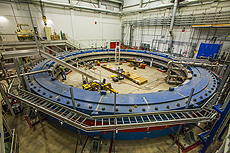Muon g-2 magnet successfully cooled down and powered up
 |
It survived a month-long journey over 3,200 miles, and now the delicate and complex electromagnet is well on its way to exploring the unknown. Photo: Cindy Arnold |
Two years ago, scientists on the Muon g-2 experiment successfully brought a fragile, expensive and complex 17-ton electromagnet on a 3,200-mile land and sea trek from Brookhaven National Laboratory in New York to Fermilab in Illinois. But that was just the start of its journey.
Now, the magnet is one step closer to serving its purpose as the centerpiece of an experiment to probe the mysteries of the universe with subatomic particles called muons. This week, the ring — now installed in a new, specially designed building at Fermilab — was successfully cooled down to operating temperature (minus 450 degrees Fahrenheit) and powered up, proving that even after a decade of inactivity, it remains a vital and viable scientific instrument.
Getting the electromagnet to this point took a team of dedicated people more than a year, and the results have that team breathing a collective sigh of relief. The magnet was built at Brookhaven in the 1990s for a similar muon experiment, and before the move to Fermilab, it spent more than 10 years sitting in a building, inactive.
"There were some questions about whether it would still work," says Kelly Hardin, lead technician on the Muon g-2 experiment. "We didn't know what to expect, so to see that it actually does work is very rewarding."
Moving the ring from New York to Illinois cost roughly 10 times less than building a new one. But it was a tricky proposition — the 52-foot-wide, 17-ton magnet, essentially three rings of aluminum with superconducting coils inside, could not be taken apart, nor twisted more than a few degrees without causing irreparable damage.
Scientists sent the ring on a fantastic voyage, using a barge to bring it south around Florida and up a series of rivers to Illinois. A specially designed truck gently drove it the rest of the way to Fermilab.
The Muon g-2 experiment plans to use the magnet to build on the Brookhaven experiment but with a much more powerful particle beam. The experiment will trap muons in the magnetic field and use them to detect theoretical phantom particles that might be present, impacting the properties of the muons. But to do that, the team had to find out whether the machine could generate the needed magnetic field.
Read more
—Andre Salles
|